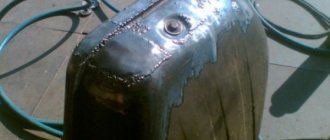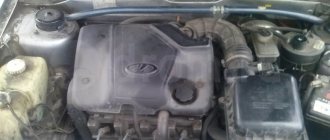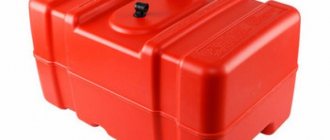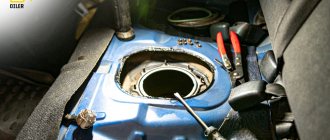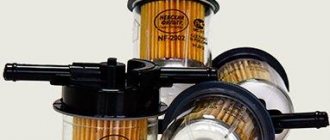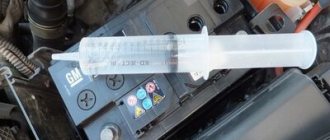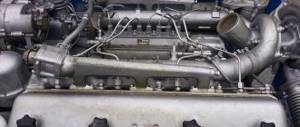The moisture remover allows you to neutralize the negative effects of water, which is found in small quantities in any fuel tank. The use of this product is especially important in winter, since it is at this time of year that moisture condenses on the inner walls of the tank the most. There are many different moisture displacers available on the auto chemical market. However, despite the fact that they are made by different manufacturers (or simply under different brands), their composition is approximately the same. Everywhere is 90% alcohol based (ethyl, isopropyl or other). It helps absorb water. Therefore, we will review the most popular ones and find out which one is best.
There are also several “folk” recipes for making fuel dryers with your own hands. To do this, you can use various alcohols, solvents, acetone or other chemical compounds that dissolve well in fuel and water and do not harm the internal combustion engine. Below you will find several such recipes.
| Product name | Brief description and features | Package volume, ml/mg | Price as of autumn 2020, rubles |
| Shell BT90l | A very effective product that can be used in both gasoline and diesel engines. Very effectively dissolves and removes water from the fuel system. An additional advantage is the low price. | 200 | 350 |
| XADO Aquastop XB 40080 | Water and ice remover from gasoline. Copes well with tasks. It is recommended to use this product every 5,000 kilometers. Perfectly protects the fuel system from moisture present in it. | 250 | 200 |
| Step UP fuel dryer | Used only in gasoline engines, carburetor, injection, including turbocharged ones. Removes water well and fights ice, harmless to plastic and rubber. Economical and inexpensive. | 355 | 300 |
| BBF moisture remover | There are two different products for gasoline and diesel engines produced under this brand. Check this moment! The effectiveness of both products can be described as average, not bad. | 325 | 150 |
| HI-GEAR fuel dryer | Designed for gasoline engines. It performs well even in severe frosts. Therefore, it is recommended for purchase. It is good to use it for preventive purposes and when preparing the car for operation in winter. | 355 | 320 |
| Winter fuel dryer Lavr | A universal product that can be used in gasoline and diesel engines. Positioned as a professional product. The only drawback is the relatively high price. | 310 | 200 |
| Moisture-displacing additive Astrohim | Also a universal product that can be used in diesel and gasoline power units. Very well protects the surface of fuel system parts from the formation of ice on them. Also effectively removes water. It's very inexpensive. | 300 | 120 |
| Runway moisture remover | There are also two different products here - for gasoline and diesel engines. When purchasing, you need to clarify this nuance. It is highly economical and has a very low price, so it is highly recommended for purchase. | 300 | 90 - petrol, 120 - diesel |
| Wynns Dry Fuel Dryer | A universal product, suitable for filling fuel into both gasoline and diesel engines. The efficiency is average, but if there are no other means at hand, then it can be used in the fuel system of a car. | 325 | 250 |
| Liqui Moly Fuel Protect Anti-Ice | It is also a universal product; it can be used with both diesel and gasoline engines. However, real tests showed the low efficiency of this moisture remover. And given its high cost, let each car enthusiast make his own purchasing decision. | 300 | 550 |
But before we look in detail at how to deal with water in a fuel tank, we’ll tell you why it forms there and why such an impurity is dangerous.
Where does the water in the fuel tank come from?
As mentioned above, water is present in small quantities in any fuel tank (both gasoline and diesel). This is due to two factors. The first and most common is simple condensation, which occurs when there is a sudden change in the temperature at which the machine is operated. In winter conditions, this happens when a car drives from the street, where the temperature is significantly below zero Celsius, into a warm garage or box. At the same time, small drops of moisture form on the inner walls of the tank, which condense and drain, settling at the bottom under the fuel. Please note that there will be more condensation on the walls of a metal tank than on the walls of a plastic one! This is due to the fact that the metal quickly acquires the temperature of its environment, that is, it has greater thermal conductivity than any plastic.
The second reason why there is water in the fuel tank is the use of low-quality fuel. This applies to both gasoline and diesel fuel. The fuel can simply be diluted with water or consist of large fractions, including a lot of moisture. This situation is relevant when the car owner refuels at gas stations with a bad reputation or simply pours something like gasoline or other substitute into the tank. Such compositions are stratified in the gas tank, and one of the components is water. In fact, this situation is very dangerous and it is better not to do this, but to try to fill the car with high-quality fuel.
Also, moisture in small quantities can enter the fuel tank when the driver refuels in the rain or snow. When the lid is open, a few drops of precipitation may get inside. Another possibility is that there may also be some moisture on the surface of the fuel nozzle (this could also be condensation or precipitation), which gets into the tank space.
How condensation appears in the gas tank
Condensation can enter the gas tank in two ways:
- moisture ends up in the tank along with the air. When the driver opens an empty tank to refuel the car, moist air enters it. The water content in this air is small, but with each new refill, more and more accumulates in the tank. And one day the accumulated moisture will begin to interfere with the operation of the engine;
- moisture enters the tank along with low-quality gasoline. As you know, the quality of gasoline in our country leaves much to be desired. There are often cases when a car owner pours gasoline diluted with water into the tank. There is only one solution: change the gas station.
To avoid failure of the car engine and costly repairs of the unit, it is necessary to periodically prevent the appearance of water in the gas tank.
It is recommended to refuel only at proven gas stations that offer customers high-quality gasoline. During operation of the vehicle, it is recommended to constantly add fuel to a full tank.
Before the onset of winter, it is recommended to add small amounts of alcohol to the tank. This will make it possible to completely remove moisture from motor gasoline.
If there is a suspicion that a large amount of condensate has collected at the bottom of the container, it is better to seek help from a service station. The technician will completely pump out the remaining fuel and water from the tank, remove it and clean it.
What is the danger of condensation in the tank?
Most of the water in the tank settles at the bottom. It goes without saying that this is harmful to the car’s fuel system, as engine power decreases and a coating forms on its working elements. And in critical situations, when there is a lot of water in the fuel, the air-fuel mixture may simply not ignite and, accordingly, the engine will not work. However, this is true for older carburetor cars.
For injection machines, the danger lies elsewhere. Their fuel system has a special filter that is designed to filter out water. At positive or slightly negative ambient temperatures, water on its surface does not freeze, and fuel passes through it freely. However, in severe frosts (down to minus 20 Celsius and below), a situation is possible when the surface of this filter freezes and literally turns into an ice floe. In this case, gasoline will flow very poorly, which can lead to difficulty starting the engine, or to the impossibility of starting it at all.
Another danger of having a large amount of condensation in a car tank is that in extreme cold the water in it can simply freeze. This usually results in a flat piece of ice floating at the bottom of the fuel tank. Also, the danger of water freezing is that it also gets on the fuel pump, and it can freeze in the same way. As a result, it operates under critical loads, that is, subject to wear. This greatly reduces its resource, up to its complete failure. In the best case, its fuse may burn out, and in the worst case, the pump itself may burn out.
To prevent the troubles listed above from occurring on a specific car, it is necessary, firstly, to fill the tank with high-quality fuel, and secondly, to use a fuel dryer for gasoline and diesel engines. Moreover, it is better to do this for prevention, because if there is a lot of water in the tank, then repair measures are needed to eliminate the consequences. When purchasing certain products, you need to carefully read their characteristics; they are specially designed for gasoline or diesel engines, and the packaging clearly indicates how much fuel a particular package is designed for.
Another danger of having condensation in a metal tank is that the moisture causes corrosion to form on its surface. And there will be more water in the tank, and the longer it stays there, the greater the danger of rusting. The entire fuel system is also subject to corrosion.
Using a dehumidifier is highly recommended as part of winterizing your car! You can also use it periodically in cold weather, especially if the car regularly drives from severe frost into a warm garage or box. Read the instructions for the specific product carefully!
How do moisture removers work?
The basis of all fuel dehydrators are alcohols (most often isopropyl or ethyl), which, without entering into a chemical reaction with water, are simply mixed with it. Thus, there will be two layers of liquid in the tank - lighter gasoline on top, and moisture mixed with alcohol at the bottom. The remaining additives included in moisture removers (for example, surfactants) are designed to protect the metal from corrosion, clean the fuel system line, and so on.
In the process of using fuel (by pumping it into the fuel rail), instead of clean water, an alcohol solution (roughly speaking, vodka) rises from the bottom of the fuel tank, which quite successfully burns together with the fuel in the combustion chamber. That is why it is quite possible to pour alcohol into the gas tank instead of a factory dehumidifier. However, we will talk about this below.
Causes and reasons for water getting into the gas tank
Water flowing from the gas tank into the injector ramp cannot cause water hammer. Its presence in the mixture of air and gasoline even to some extent helps to clean the combustion chamber and piston bottoms from carbon deposits. However, water is harmful to the fuel system. The fuel pump breaks down, the injectors become clogged with mineral salts released from the water.
It is known that spare parts for car repairs are expensive, and if you do not take care of timely technical maintenance, then paying for troubleshooting is many times more expensive. For example, the Opel Astra (“Puki”) has not been used for three years. The long downtime resulted in the replacement of expensive injectors.
It gets inside mainly along with fuel. Diesel fuel or gasoline at a little-known gas station may contain more water, so choose well-known and proven gas stations.
Condensate. The tank is not a sealed structure, and in addition to fuel there is air. Moisture can appear as a result of sudden temperature changes - we drove into a heated garage from the cold. Moisture accumulates, forming water droplets. The problem with condensation occurs when the ambient air becomes very humid.
Water may appear in the gas tank when you drive into a warm garage from the cold in winter, or vice versa. But what does finding water in the tank of a car lead to?
The water in the tank is dangerous because it freezes in cold weather, resulting in the formation of ice, which can prevent fuel from entering the fuel system. The presence of liquid can cause the fuel pump to freeze, and then it will simply be impossible to start the car.
Freezing water can also cause the fuel pump to fail. Without suspecting the presence of water in the gas tank, you will start the car, at best the fuse will burn out, at worst the pump itself will fail. In this case, it is necessary to urgently remove the water from the gas tank.
It is also dangerous if water gets into the fuel line. Leaving your car in cold weather for some time can cause water in the fuel line to freeze, completely clogging the system. As a result, when you try to start the engine, no fuel will flow.
More on the topic Why the engine overheats: consequences, what to do
In the warm season, due to the presence of water in the gas tank, some loss of engine power is felt. There is a decrease in engine power due to fuel and water entering the combustion chamber of the engine. And what to do in this case, how to remove water from the car’s gas tank, what means can be used, read on.
Moisture often enters the car tank when it is refueled at a gas station along with air. No matter how tightly the refueling nozzle fits into the neck of the fuel tank, a small amount of air enters the container. And the temperature difference contributes to the formation of condensation, which settles in drops to the bottom of the container.
Moisture that gets into the fuel tank does not mix with gasoline or diesel; it precipitates at the bottom of the tank. When the fuel in the tank is at zero, clean water enters the fuel system and the car engine. This leads to damage to injector nozzles, fuel injectors, and problems with engine operation. It may flood the spark plugs, but the engine will not start and will start to stall.
The main symptoms of the presence of moisture: corrosion of the metal tank, rust getting into the cylinder blocks. And this can lead to premature repair of the power unit or replacement of units.
Condensation that seeps into the gas tank during the winter cold is especially dangerous. It can cause ice to form in pipelines, thus causing an ice barrier. This problem is solved by thawing in an underground parking lot or in a heated garage. But the possibility of driving a car into a warm place does not always exist, and it may be necessary to sort it out “here and now.”
When water has frozen in the pipelines, getting rid of the ice obstruction during “emergency” occurs by warming the pipes and then pumping the system. You will need to disconnect the fuel supply and turn the starter until clean fuel comes out. Therefore, you should prepare for the fact that the process will take a long time and require considerable effort.
Along with refueling with low quality fuel, the basis for the appearance of moisture inside the fuel tank is the natural physical process of condensation. When filling, air enters the container, condensed moisture settles on its walls and flows with water to the bottom.
The problem gets worse in the following cases:
- The car is always half full.
- In addition, when pouring fuel in rain or fog, the likelihood of moisture entering increases.
- If a car spends the night inside a warm garage in winter, then water accumulates especially intensively.
In the lower layers of the fuel tank, water collects all the dirt like a sponge and activates corrosion processes. At the same time, it does not evaporate, since it has a higher density compared to gasoline. Penetrating into fuel equipment, moisture destroys it due to the cavitation effect. In addition, the lubrication functions of fuel system parts are disrupted.
The water accumulated inside the fuel tank can cause the greatest harm in winter, since it can simply freeze, causing breakdowns of the fuel pump and injector nozzles.
Due to the ice formed inside the fuel channels, an insurmountable barrier to gasoline is formed. In diesel engines, the injection pump plunger pair often fails.
Rating of popular moisture displacers
The variety of tank moisture removers often confuses the car owner and makes it difficult to make the right choice. Based on real reviews and tests found on the Internet, our team has compiled a rating of the most popular products. Some of them work really well, and some of them not so much. This listing is not commercial in nature and does not promote any of the ingredients featured. It is designed to help car owners decide on a particular dehumidifier by providing a complete description of the product.
Shell BT90l
Shell BT90l fuel moisture displacer is perhaps one of the most effective means in this regard. This can be judged by tests performed by different car owners and experts. The product is universal and can be used with both gasoline and diesel engines.
An additional advantage is the low price. The moisture displacer dissolves in the fuel and turns the moisture first into some balls like silicone, which then completely dissolve. Shell BT90l does not harm rubber products of the vehicle fuel system, hoses, gaskets, and so on. Therefore, the product is definitely recommended for purchase by any car owners.
Shell fuel moisture displacer is sold in a small plastic canister with a volume of 200 ml. The article number for this packaging is 5901060022108. The price as of autumn 2020 is about 350 rubles.
1
XADO Aquastop XB 40080
XADO Aquastop XB 40080 is positioned by the manufacturer as a remover of water and ice from gasoline. It contains alcohols, surfactants, detergent-dispersant additives (from BASF), as well as aliphatic hydrocarbons that help to effectively dissolve water and melt ice. In addition to directly displacing moisture, it also helps to increase the efficiency of the fuel system, protects against damage by ice crystals in winter, and prevents icing of individual elements of the fuel system.
Real tests have shown that the additive interacts quite well with water, but in some cases an oily film may form between the fuel and unadsorbed water at the bottom. The manufacturer recommends adding the product before the next refueling. The packaging also states that the maximum effect from its use can be achieved by regularly using it every 5,000 kilometers.
Sold in a small plastic bottle of 250 ml. Product code: XB40080. The price for the above period is about 200 rubles.
2
Step UP fuel dryer
The Step UP fuel dryer is intended for use in gasoline engines, both carburetor and injection, including turbocharged ones. Positioned as a professional product, therefore suitable for any car with gasoline engines. Absolutely safe for afterburners, catalytic converters, oxygen sensors, fuel system elements made of rubber and plastic. In addition, it does not corrode the metal surfaces of its parts. Improves fuel combustion, binds water well and promotes its removal with exhaust gases.
Real tests and studies have shown that the StepUP fuel dryer really copes well with the tasks assigned to it and removes water from the car’s fuel system quite well. Even in extreme cold, it promotes smooth engine starting. Therefore, this composition is definitely recommended for purchase by car enthusiasts.
Sold in 355 ml packaging. Its article number is SP3322. The price of such a package is about 300 rubles.
3
BBF moisture remover
BBF moisture remover effectively binds and removes water from the vehicle's fuel system. There are two similar products with the same names, but one is designed for gasoline engines and the other for diesel engines. Therefore, be sure to check this nuance before purchasing! This dehumidifier not only directly removes water from the fuel tank and the entire fuel system, but also reduces the pour point (for diesel fuel additives) and also makes it easier to start the engine in cold weather. The manufacturer suggests using one package (325 ml) for 40...60 liters of fuel. It is recommended to use the product every two to three refills during the cold season and/or when there is a sharp change in ambient temperature.
Real tests showed good effectiveness of the product. And given its low price, this moisture remover can be an excellent option when choosing a similar composition.
Both products (for gasoline and diesel engines) are sold in identical 325 ml packages. Their articles are: 3310 - gasoline, 3311 - diesel. The price of one and the other is the same and ranges from 100...150 rubles.
4
HI-GEAR fuel dryer
Hi Gear fuel dryer is designed for use in gasoline engines in winter. It effectively removes moisture from the gas tank, and also melts ice and prevents it from forming in the future. In addition, it ensures easy starting of the car engine even at very low temperatures. Does not harm rubber products of the vehicle fuel system. Protects metal surfaces from corrosion and keeps the fuel line clean.
Tests of the Hi-Gear moisture remover showed its effectiveness to be average. It does not fully dissolve in water, so it may not be completely removed from the gas tank. But still, it can be used as a preventative measure and will not be out of place in the collection of any car enthusiast, so the majority of consumers are still happy with it.
Sold in a 355 ml bottle. This packaging has the article number HG3325. The average price of a bottle is 320 rubles.
5
Winter fuel dryer Lavr
Positioned by the manufacturer as a winter universal fuel dryer Lavr. Can be used in both gasoline and diesel engines. It removes moisture well, defrosts icing and prevents it from re-forming. Makes it easier to start the engine in frosty weather. Absolutely safe for rubber products, hoses, oxygen sensors, catalysts. It also does not cause corrosion on metal surfaces. The manufacturer recommends adding this product before the next refueling. One package is enough for 40...60 liters of fuel.
The “Lavr” fuel dryer is currently used by many car enthusiasts, which indicates its real high efficiency in removing moisture from the fuel system. The only drawback of this product can be considered its relatively high price compared to other similar samples and poor protection against rust of the tank.
Sold in 310 ml packaging. For ease of use, the packaging includes an extension funnel, which facilitates the process of pouring the product into the tank. Packaging code: LN2125. And its price is 200 rubles.
6
Moisture-displacing additive Astrohim
The Astrohim moisture-displacing additive is a universal product and can be used both in cars with a gasoline engine and a diesel engine, including those with a turbocharger. It is absolutely safe for oxygen sensors and catalytic converters. It removes water from the tank well, and in the cold season it promotes defrosting and prevents its occurrence on an ongoing basis, even in severe frosts. This makes it much easier to start the engine at very low temperatures. The additive does not contain methyl alcohol, so it is not toxic. However, contact of the composition with the eyes should be avoided. Otherwise, rinse them with plenty of water.
The manufacturer recommends using a dehumidifier every time you refuel your car in winter, and every 3,000 kilometers in summer. One package of this product is suitable for 60...80 liters of fuel. Moreover, the composition must be filled before the next refueling. The effectiveness of the moisture remover can be described as average. It will cope well with its tasks in mild frosts, but if the temperature drops significantly, this property will remain in question.
Sold in 300 ml packaging. The bottle itself has a narrow, long neck, which makes it easy to pour the product into the fuel tank. The article number for this product is AC110. The price is 120 rubles.
7
Runway moisture remover
Two products are sold under the Runway brand: a gas tank dehumidifier and a diesel fuel dehumidifier. Therefore, check this point when purchasing. In general, the products are positioned as effective fuel dehydrators, but in practice they are capable of raising H2O less than others and do not retain it for long. They prevent corrosion on metal parts of the fuel system, do not harm its rubber parts, and are harmless to oxygen sensors and catalysts. It is highly economical; one package is enough for 60 liters of fuel. Promotes better combustion. Prevents freezing of the system and removes ice crystals from liquid fractions of water and fuel.
A good advantage of this product is its low price and high efficiency. Therefore, it is quite possible to buy it for use in a car in winter or when preparing it for the cold season.
Both petrol and diesel versions are sold in identical 300 ml bottles. The bottles have a high, narrow neck, allowing you to conveniently pour the product into the fuel tank. The article number of the gasoline dryer is RW3011, the diesel one is RW3071. Their prices are 90 and 120 rubles, respectively.
8
Wynns Dry Fuel Dryer
The Wynns Dry Fuel Dryer is suitable for both petrol and diesel engines. Quite effectively removes condensate from the fuel tank. In addition, it protects metal parts from the formation of corrosion on their surface, does not harm rubber parts, and is safe for oxygen sensors and catalysts. Makes it easier to start the engine in cold weather. Also helps clean injectors. Effectively fights ice crystals.
Real tests have shown the average efficiency of this dehumidifier, so whether to buy such a product or not is up to each car enthusiast to decide for himself. However, it can be used if there is no other alternative in the store or at hand at the moment. Still, it is better to use such a product in winter than not use anything.
Wynns Dry Fuel is sold in 325 ml packaging with a long neck for easy pouring into the fuel tank. The article number for this package is W71851. Its price is about 250 rubles.
9
Liqui Moly Fuel Protect Anti-Ice
Liqui Moly Fuel Protect Anti-Ice fuel dehydrator is a universal product and can be used in both gasoline and diesel engines. Positioned by the manufacturer as a protective ash-free product. It is a self-mixing composition that includes alcohols and active substances. This fuel dryer is absolutely harmless to turbines and catalysts. In addition, it protects the fuel system from icing and metal surfaces from corrosion. The manufacturer recommends adding this composition at each refueling at the rate of 300 ml (full can) per 60 liters of fuel.
Real tests of the Liqui Moly Fuel Protect fuel dryer showed its very mediocre effectiveness, despite the worldwide popularity of this brand. The additive mixes with water rather mediocrely, and therefore removes it from the fuel tank with low efficiency. And given its fairly high price compared to its competitors, the advisability of its purchase is highly questionable. But a test with a nail in fuel showed that this liquid moth desiccant protects well from corrosion. But let each car owner decide for himself...
Sold in a small 300 ml bottle. For ease of pouring the product into the fuel tank, a plastic extension spout is included. The article number of this package is 3964. The price of the dehumidifier is about 550 rubles.
10
If you have had experience using any of the listed or other similar tools, write about it in the comments.
How to make a fuel dryer with your own hands
The means presented above have different, however, quite high effectiveness. But they all have one drawback - a relatively high price, especially if you use them on a regular basis. In fact, there are several so-called “folk” methods for making such desiccants, especially since their composition is quite simple. Therefore, if for some reason you do not want or cannot buy a factory-made moisture remover, make it yourself using one of the recipes given.
Such an additive can only remove water from the tank, but does not protect the fuel system from corrosion.
Alcohols . You can add a little alcohol to dry the moisture in the fuel tank. This can be methyl, ethyl or isopropyl alcohol (technical). Please note that methyl alcohol is a poison and cannot even be inhaled , so it should only be used as a last resort if nothing else is available! As for the dosage, the volume of alcohol is about 200...250 ml per 40 liters of fuel.
Solvents . The simplest and most accessible in this vein will be “Solvent” or acetone (pure). They have the same density as gasoline when mixed with water. They also need to be added in small quantities. In particular, about 200...250 ml of acetone is enough for 40 liters of fuel, and Solvent - 250...300 ml for the same 40 liters of fuel. However, in this case, acetone is preferable because it dilutes moisture better and removes it faster and better through the fuel system. Please note that acetone cannot be poured into the tank very often, approximately once a year, when preparing the machine for use in winter.
The compositions listed above do not react chemically with moisture, but only dissolve in it. After their use, a certain heavier layer (usually cloudy white) forms at the bottom of the gas tank, which contains water. And this composition can easily be pumped into the system by a gasoline pump and pass through the filter mentioned above, and then burn in the cylinders..
Conclusion
Using a factory-made or homemade dehumidifier is a good preventative measure that is advisable to use in the fall or winter. This is especially true for machines operated in severe frost conditions. The use of dehumidifiers must be carried out as part of measures to prepare the car for winter (along with replacing tires, checking the heating system, and so on).
Such compositions will certainly protect the fuel system of cars, and will also restore engine power if low-quality fuel is used. All of the compositions listed above are definitely recommended for purchase, and which one to choose is up to you!
Preventing water in the gas tank
It is possible to get rid of troubles associated with water getting into the gas tank using preventive methods:
- refuel the car at a reliable and trusted gas station;
- regularly check the tightness at the junction of the fuel pump module with the tank and the incoming pipes to it;
- when parking the car for a long time, fill the tank to its full capacity (“to the neck”);
- regularly (once a quarter) fill the tank with alcohol-containing liquids (moisture desiccant, water displacer or remover, etc.) to remove water condensate;
- install locks that block the opening of gas tank caps from ill-wishers.
This was in the late nineties. Several Mercedes dump trucks were driven to the far north and given an instructor so that Russian drivers would not break the miracle of German technology. The instructor sat with the driver and taught the wisdom of driving. And so, moving along the winter road, the dump truck catches up with our military truck.
— The fuel has apparently run out.
- Do you have fuel in the ditch?
- No, water.
Pause for ten minutes.
- Do you have motors that run on water?
More on the topic Installing and connecting a radio in a car with your own hands, decoding the ISO connector
- No, he’s in the solarium!
— Why isn’t your fuel intake all the way to the bottom?
- What if there is water in the tank!?
